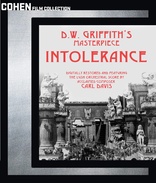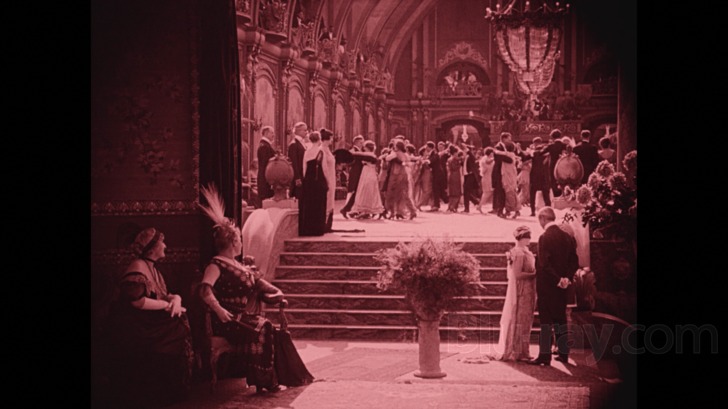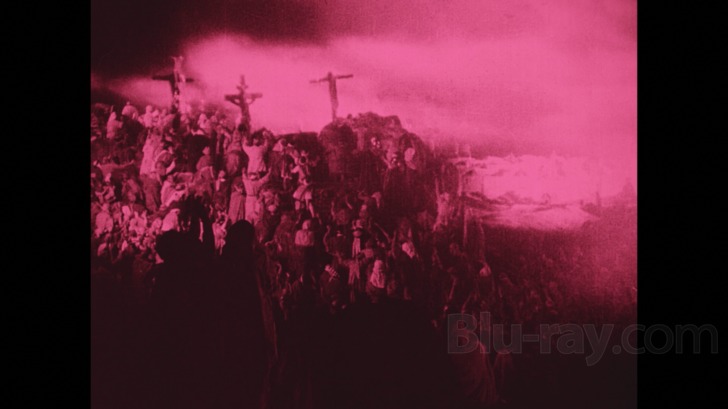Intolerance Blu-ray Movie
HomeIntolerance Blu-ray Movie 
Intolerance / The Mother and the Law / The Fall of BabylonCohen Media Group | 1916 | 1 Movie, 3 Cuts | 168 min | Not rated | Nov 05, 2013

Movie rating
7.6 | / 10 |
Blu-ray rating
| Users | 0.0 | |
| Reviewer | 4.5 | |
| Overall | 4.5 |
Overview
Intolerance (1916)
Four separate stories are interwoven: the fall of Babylon, the death of Christ, the massacre of the Huguenots, and a contemporary drama, all crosscut and building with enormous energy to a thrilling chase and finale. Through the juxtaposition of these well known sagas, Griffith joyously makes clear his markedly deterministic view of history, namely that the suffering of the innocents makes possible the salvation of the current generation, symbolized by the boy in the modern love story.
Starring: Lillian Gish, Miriam Cooper, Bessie Love, Mae Marsh, Eugene PalletteDirector: D.W. Griffith
| Drama | 100% |
| History | 14% |
Specifications
Video
Video codec: MPEG-4 AVC
Video resolution: 1080p
Aspect ratio: 1.33:1
Original aspect ratio: 1.33:1
Audio
English: DTS-HD Master Audio 5.1
English: DTS-HD Master Audio 2.0
Subtitles
None
Discs
50GB Blu-ray Disc
Two-disc set (2 BDs)
Playback
Region A, B (C untested)
Review
Rating summary
| Movie | 4.5 | |
| Video | 4.5 | |
| Audio | 4.5 | |
| Extras | 3.0 | |
| Overall | 4.5 |
Intolerance Blu-ray Movie Review
Incredible.
Reviewed by Jeffrey Kauffman October 28, 2013Films come and go in such huge quantities and with such an ephemeral nature that more often than not today’s sensation is tomorrow’s forgotten “masterpiece”. Our society has only become more prone to attention deficit disorder as time has marched solidly on through any number of new media distractions. And so isn’t it rather remarkable that Intolerance should have remained so iconic for so long, especially when one considers that for many, both casual viewers and experts alike, the film is one of those “must see—once” events that is perhaps better appreciated as a symbol than for any intrinsic worth? While that assessment may be questionable (at the very least), Intolerance stands tall as one of the crowning achievements of silent cinema. This gargantuan production runs for a rather staggering two-plus hours (there are several extant versions available), utilizes a then unusual cross cutting technique that simultaneously unfolds four stories from radically different time periods, and contains some of the most gigantic set pieces—and sets, for that matter—ever assembled in the history of film. David Wark Griffith had just experienced unbelievable success with The Birth of a Nation in 1915, but had also found himself mired in controversy because of that film’s patently shocking portrayal of African Americans and its lionization of the Ku Klux Klan. Restorer and archivist Kevin Brownlow, who oversaw this restoration of Intolerance and who appears on a fascinating supplement included on this two disc set, dismisses some of the widely held notions that Intolerance is therefore an “apology” for The Birth of a Nation, and he points to one salient fact to back up his assertions: of all the examples of prejudice floating through Griffith’s immense epic, there is absolutely no mention of racial bigotry, at least when directed at blacks. Griffith’s motives notwithstanding, Intolerance is an astounding film experience, one that indeed any serious student to film absolutely must see—and I would argue more than merely once—if he or she is to understand the history of the art form, for Griffith’s approach in Intolerance most certainly influenced generations of filmmakers and created a template for what would ultimately become known as an “event film” or “historical epic”.

Though many have drawn a through line directly from The Birth of a Nation to Intolerance, Brownlow correctly points out that more appropriate antecedents, at least in terms of Intolerance’s epic scale, would be two Italian silents, 1912’s Quo Vadis and 1914’s Cabiria, both of which D.W. Griffith had seen and been blown away by. But Griffith really didn’t set out to make his follow up to The Birth of a Nation even be an epic. He had instead been working on a contemporary moral drama called The Mother and the Law. In fact, as Brownlow also relates, once Griffith did decide to start adding the different time frames and attendant stories, he temporarily named them The Mother and the Law #2, The Mother and the Law #3 and The Mother and the Law #4. But Griffith’s most distinctive contribution to film technique was his ultimate decision to cross cut between these four disparate tales, allowing each of them to comment upon each other. It may not have exactly been montage theory as it was later espoused by Eisenstein, but it came close. Ironically, this approach was confounding to audiences who first saw the film in 1916 and that, along with the film’s rather unwieldy length, contributed to Intolerance being a huge financial failure, doing more than its fair share to wipe away the untold millions Griffith had reaped a mere few months earlier with The Birth of a Nation.
Griffith confounds expectations—at least for those who probably assumed he was a right wing zealot based on The Birth of a Nation—by taking a decidedly left leaning, rabble rousing, labor sympathizing reformer stand in the most modern story of the quartet of interlocking tales in Intolerance. A young couple known only as The Boy (Robert Harron) and The Dear One (Mae Marsh) find their lives turned upside down by the dastardly activities of ruthless capitalists (including a thinly veiled version of John D. Rockefeller) and, perhaps even more troublingly, a gaggle of doyennes whose mission in life is to make everyone conform to their ideas of morality (sound familiar?). Things quickly go from bad to worse in this story, with The Boy eventually incarcerated and facing the gallows, while The Dear One suffers stoically, even though her baby has been taken from her by the "moral police".
Playing alongside this tale of woe are three historical epochs, including a rather brief tour of Jesus’ (Howard Gaye) last days, as well as two other eras where innocent “civilians” get caught up in huge historical maelstroms. One of these is the 16th century French Catholic persecution of the Huguenots, which wreaks havoc on a young couple played by Margery Wilson and a completely unrecognizable Eugene Pallette, miles away from his portly comic portrayals of the 1930s and 1940s. The other, perhaps Intolerance’s most famous set of sequences, depicts the calamitous intersection of Persia and Babylon, with Babylon getting the short end of the sacred idol. A so-called Mountain Girl (Constance Talmadge, who also appears in the French story as another character) finds herself caught between both the social and religious morés of conflicting cultures and belief systems. This storyline includes the massive set that has become Intolerance's most indelible image (see screenshot 3), a towering structure which was the biggest set ever built to that time. Literally tens of thousands of extras were utilized in several enormous set pieces in this tale.
There’s no avoiding the fact that Intolerance can indeed seem clunky some of the time, and my hunch is, it even seemed that way to awestruck 1916 audiences, perhaps one reason the film was such a resounding flop. The three historical stories, even that of Jesus, seem too artificial to really connect with audiences, and the recurrent trope culled from Walt Whitman's line "out of the cradle endlessly rocking" seems to only indicate that the film, like time itself, may never end. But from a historical perspective, the importance of Intolerance simply can’t be understated. Not only is its intercutting technique revolutionary, Griffith handles the camera with what was then fairly unusual uses of tracking, dollying and even crane shots. He almost single handedly helped to create the vocabulary for the epic film with Intolerance, and many of his techniques are still in use today.
From a dramatic standpoint, it’s probably true that only the “modern” story really resonates, and in fact there’s a good reason that Griffith excised it and released it as a standalone film (included on the second disc of this two disc set). That of course is the ultimate irony about Intolerance—Griffith had originally only set out to make The Mother and the Law, and then branched out in a huge mutation that saw him include the three other storylines, when really it was his first concept that turned out to be the best. While there’s a nihilistic quality to the story of The Boy and The Dear One, there is undeniable tension built up when it appears that The Boy is in fact going to meet his maker before justice can finally be served. Thankfully one other artifice Griffith helped establish was the happy ending.
Intolerance Blu-ray Movie, Video Quality 

Intolerance is presented on Blu-ray courtesy of Cohen Film Collection with an AVC encoded 1080p transfer in
1.33:1. The progressive
presentation may put off some who are more sensitive to the algorithms of silent film fps protocols and how they fold into
Blu-ray authoring
requirements for 24 fps progressive presentations. While I've seen many sources reporting various silent films repeating
a
rather wide disparity of
frames (everything from every
fifth
or sixth to every eighteenth and beyond) to support a progressive presentation, my entirely unscientific research on
Intolerance
suggests that in this case it's every third or fourth frame that is being repeated—whether that will alleviate any perceived
motion issues or exacerbate them I will
leave to those with this particular acuity, as I frankly have never been overly bothered by previous silents presented
progressively, and in fact
I saw little if any difference between the progressive and interlaced presentations of The Phantom of the Opera (24 fps in 1080p, 20 fps in 1080i) with regard to
fluidity of motion.
This version runs 168 minutes (2:47:32 to be exact) and so the frame speed may have been increased since several sites
state this version
"should" run 197 minutes or thereabouts. That said, I certainly noticed no overt "sped up" syndrome in any of the
motion. The Thames Silents
Restoration which served as the source for this release was initially overseen by Kevin Brownlow and David Gill in 1989,
and according to the
press sheets accompanying the Blu-ray release, also received further digital restoration as well as a 2K scan by Cohen for
this release. The
results are fairly
miraculous, at least for
those of us who grew up on hideous looking public domain issues of the film sourced from horrible looking 16mm prints.
There are obviously
quite a few issues inherent in the source elements—scratches, missing frames, etc.—but when compared to previous
releases of
Intolerance, well—to my eyes, anyway, there is no comparison. Many of the most prominent instances of
damage have been
wiped away, without destroying grain structure. In fact, one almost has to get one's nose right to the screen to even
see some of the
scratches now, so minimal have they become. It should be stated that due to the reinstatement of the original tints,
grain appears to
be variable. It tends to be much more visible in the untinted sequences as well as the sepia and blue tinted ones than in
the reddish-purple
tinted sequences, where it all but disappears.
The image, while certainly not crystal clear or "sharp" by today's standards, is remarkably precise. Fine detail is minimal, if
only because Griffith
only uses close-ups very sparingly, and even then, often with irises employed (see screenshot 7 for a good
example of a non-irised
close-up). Density and
contrast issues are slight, but noticeable, lending a quasi-flicker sporadically throughout the presentation. Aside from the
damage restoration,
there are no signs of artificial sharpening or other digital tweaking. Having owned several versions of
Intolerance going back
to
the VHS days, I can state without qualification that this is easily the best looking version I've personally seen.
Intolerance Blu-ray Movie, Audio Quality 

Intolerance offers Carl Davis' magnificent score (built almost entirely on a C minor motive which then expands and contracts in magical ways over the course of the next two-plus hours) in either DTS-HD Master Audio 5.1 or DTS-HD Master Audio 2.0. Davis, who I felt channeled Prokofiev's Fifth Symphony for his wonderful theme music for The World at War, here forsakes outright homages or pastiches to create a remarkable blending of tone with image. (He does liberally quote the Dies Irae at some of the more dramatic moments.) The score is really resplendent sounding in the 5.1 mix and I highly recommend that option for those with the appropriate setup. Not only are the surround channels fully engaged, the score breathes much more convincingly in the 5.1 mix, with a much fuller sounding midrange and lower range. Fidelity is superb and dynamic range is extremely wide.
Intolerance Blu-ray Movie, Special Features and Extras 

The second disc of this two disc set contains these supplements:
- The Mother and the Law (1080p; 1:39:32) is the 1919 re-edit of the "modern" story from Intolerance, "with changes and additions" according to the first intertitle. The score is by the Mont Alto Motion Picture Orchestra. The difference in video quality between this and Intolerance is frequently astounding.
- The Fall of Babylon (1080p; 1:02:34) does much the same thing for the Babylonian sequences from Intolerance, and again includes a score by the Mont Alto Motion Picture Orchestra. This is in somewhat better shape than The Mother and the Law.
- 2013 Restoration Trailer (1080p; 2:08)
- Three Hours That Shook the World: Observations on Intolerance (1080p; 19:02) is an interview with Kevin Brownlow which includes occasional clips and stills from the film. He has a ton of fascinating anecdotes about the film and its participants, including a really funny story involving David Shepard, another vaunted name in silent film, and Intolerance's editor, James Smith.
Intolerance Blu-ray Movie, Overall Score and Recommendation 

Yes, you must see Intolerance at least once if you have any interest in the history of film. The good news is, with this often stunning restoration, chances are you're going to watch it again. While I wish this release had included some kind of commentary (there are two good essays in the insert booklet), otherwise this is a topflight release and one of the most impressive high definition presentations of a silent film I've yet seen. Highly recommended.
Similar titles
Similar titles you might also like

The Crusades
1935

Age of Uprising: The Legend of Michael Kohlhaas
2013

The Birth of a Nation
Limited Edition to 3000
1915

Kagemusha
影武者
1980

Napoléon
Napoléon vu par Abel Gance
1927

Aquarius
2016

Zama
2017

Henry V
1944

Taras Bulba
1962

Edward II
1991

Blancanieves
Snow White
2012

The War Lord
1965

The White Princess
2017

Die Nibelungen: Siegfried
1924

A Touch of Sin
天注定 / Tian zhu ding
2013

Stray Dogs
郊游 / Jiao you
2013

Soleil Ô
Oh, Sun
1967

Cemetery of Splendor
2015

Clouds of Sils Maria
2014

The Passion of Joan of Arc
La passion de Jeanne d'Arc
1928